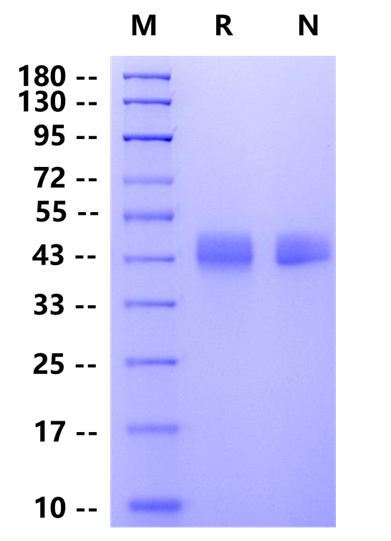Glu296-Gly580, with C-terminal 8*His & Avi tag EVEKTACPSGKKAREIDESLIFYKKWELEACVDAALLATQMDRVNAIPFTYEQLDVLKHKLDELYPQGYPESVIQHLGYLFLKMSPEDIRKWNVTSLETLKALLEVNKGHEMSPQAPRRPLPQVATLIDRFVKGRGQLDKDTLDTLTAFYPGYLCSLSPEELSSVPPSSIWAVRPQDLDTCDPRQLDVLYPKARLAFQNMNGSEYFVKIQSFLGGAPTEDLKALSQQNVSMDLATFMKLRTDAVLPLTVAEVQKLLGPHVEGLKAEERHRPVRDWILRQRQDDLDGGGSHHHHHHHHGLNDIFEAQKIEWHE
42-50kDa
1、Hassan R. et al. (2004) Mesothelin: a new target for immunotherapy. Clin. Cancer Res. 10: 3937.
Mesothelin, also known as CAK1 and ERC, is derived from a 70 kDa precursor that also includes Megakaryocyte Potentiating Factor (MPF). The 70 kDa precursor is expressed on the cell surface where it is cleaved at a dibasic proteolytic site to release the 32 kDa glycosylated MPF. MPF is a cytokine that potentiates IL-3 induced megakaryocyte colony formation. The term Mesothelin refers to the 40 kDa glycosylated protein which remains attached to the cell surface via a GPI linkage. Both MPF and the cleaved form of mesothelin are N-glycosylated. Mesothelin / MSLN can interacts with MUC16. The membrane-anchored forms of MSLN may play a role in cellular adhesion. MPF potentiates megakaryocyte colony formation in vitro.


Immobilized Biotinylated MSLN His&Avi Tag, Human (Cat. No. UA010438) at 2 μg/mL on Streptavidin precoated (0.5μg/well) plate, can bind Anti-Human MSLN Monoclonal Antibody (Amatuximab) with EC50 of 2.66-3.45 ng/ml.